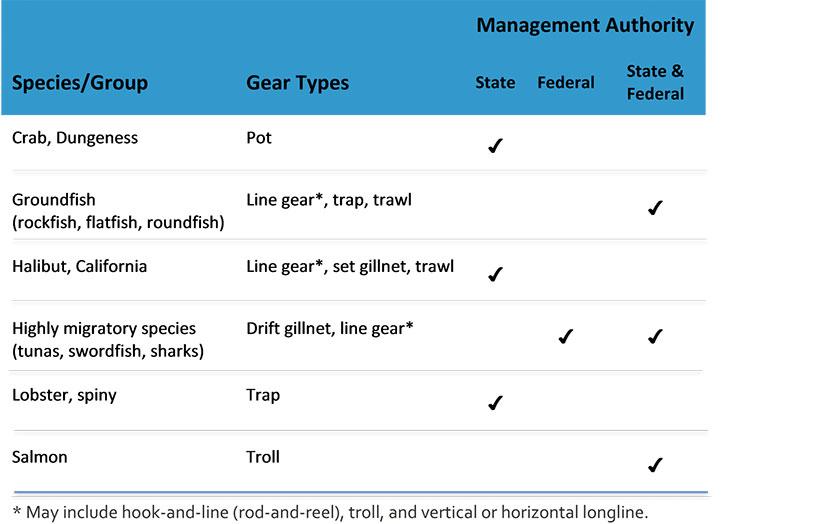Breadcrumb
- Discover California commercial fisheries
- Management context
Management context
California fisheries – and fishery participants – are managed by diverse state and federal regulations designed and implemented by several agencies. All commercial fishermen (captains and crew) are required to have a license from the state (renewed annually). In addition, nearly all fisheries require a fishery-specific permit. Similarly, businesses that purchase seafood from fishermen are required to have appropriate licenses and permits and to meet health and safety standards designed to ensure that seafood provided to the public has been handled properly.
Here we describe:
- Common management tools
- Management authorities and frameworks
- Fishery management plans for California fisheries
For information on how fisheries data are collected and analyzed, see the “Measuring Fishery Activity” page.
Common management tools
Fisheries are managed using a combination of regulations aimed at allowing appropriate catch levels to sustain healthy marine ecosystems and associated coastal communities. Regulations can differ across regions, especially with variations in fishery resources, marine environmental conditions and fishing practices. The most common management measures are:
- Closed seasons and/or areas - prohibit fishing for one or more species at particular times (e.g., spawning seasons) and/or places (e.g. rockfish conservation areas (RCAs), marine protected areas (MPAs))
- Gear restrictions - set standards such as minimum mesh sizes for nets, specific types of hooks, or minimum size of escape ports for traps
- Size limits - control what size animals can be retained and sold
- Restricted access (including limited entry) - limits the number of participants in a fishery
- Quotas - limit the amount of fish that can be taken over a specified period of time by the entire fleet and/or individuals (e.g., catch shares)
- Landing or trip limits - similar to quotas, these limit the amount of fish landed per trip and/or the number of trips per season
Management authority
Fisheries are managed through state, federal and international processes. Who manages a fishery depends largely on where it occurs:
- State waters: 0-3 nautical miles from shore
- Federal waters: 3-200 nautical miles from shore
- International waters: outside the 200- nautical mile US Fisheries Conservation Zone
Some species that move along the entire West Coast, such as sardines, are managed at the federal level even though they are caught primarily in state waters. In some cases (e.g., tunas, Pacific halibut, salmon), fisheries also may be subject to international management agreements, which in turn influence federal and state management. The following chart provides a few examples of California fisheries and associated management authority.

Multiple government agencies manage California fisheries, guided by overarching and fishery-specific policies, including:
- The California Legislature and the California Fish and Game Commission (CFGC) establish policy and provide guidance to the California Department of Fish and Wildlife (CDFW) for management of the state’s fisheries (consistent with any federal fishery management plans (FMPs)).
- The Marine Life Management Act (MLMA) of 1998 delegated state fishery management authority from the Legislature to the CFGC for commercial fisheries that had not been managed by legislative action prior to the Act's passage. (Some fisheries previously managed by the Legislature such as squid have been '"grandfathered" in so that they fall under provisions of the MLMA.)
- The Marine Life Protection Act (MLPA), passed by the California Legislature in 1999, provided for the establishment of a network of marine protected areas, including areas that prohibit some or all commercial fisheries.
- The Magnuson-Stevens Fishery Conservation and Management Act (MSA), passed by Congress in 1976, was the nation’s first comprehensive federal fisheries legislation. The MSA established eight regional fishery management councils, and required the development of FMPs for fisheries that occur in federal waters. The MSA was amended as the Sustainable Fisheries Act (SFA) of 1996, and identified 10 National Standards to guide FMP development and federal fishery management more generally. (The MSA is reauthorized every 10 years.)
- The Pacific Fishery Management Council (PFMC) designs management measures for fisheries that occur in federal waters along the coasts of California, Oregon and Washington. The Secretary of Commerce evaluates the measures which, if approved, are implemented by the National Marine Fisheries Service (NMFS).
California fishery management plans
As mandated by federal and state policy, CDFW, CFGC, PFMC, and NMFS staff create and update FMPs for species (e.g., white seabass) or species group (e.g., groundfish) with input from scientists, fishery managers and stakeholders. While the state and federal processes differ somewhat from one another, both involve the analysis of biological, environmental, economic and social factors affecting the fishery, with development and modification (as needed) of management alternatives and regulations. As such, these documents cover a range of information including the history of the fishery, the biology and status of the fishery population(s), the socioeconomics of the fishery, and management alternatives. Each FMP undergoes public and agency review before it is approved and implemented. In some cases, state- or federally-appointed advisory groups, which include fishery participants and representatives of environmental non-governmental organizations and the general public, play an ongoing role in the management process.
Information sources
California Code of Regulations, Title 14 - complete listing of state fishing regulations
CDFW. 2014. California Fishing Regulations Commercial Digest 2014-2015. Sacramento, CA: The Resources Agency, CDFW, 129 pp.
Leet, W.S., Dewees, C.M., Klingbeil, R. and E.J. Larson. 2001. California's Living Marine Resources: A Status Report. 4th ed. Sacramento, CA: CDFG, 562 pp.
Wallace, R., and K. Fletcher. 2001. Understanding Fisheries Management: A Manual for understanding the Federal Fisheries Management Process, Including Analysis of the 1996 Sustainable Fisheries Act. 2nd ed. University, MS: Mississippi-Alabama Sea Grant Consortium.
California legislative information